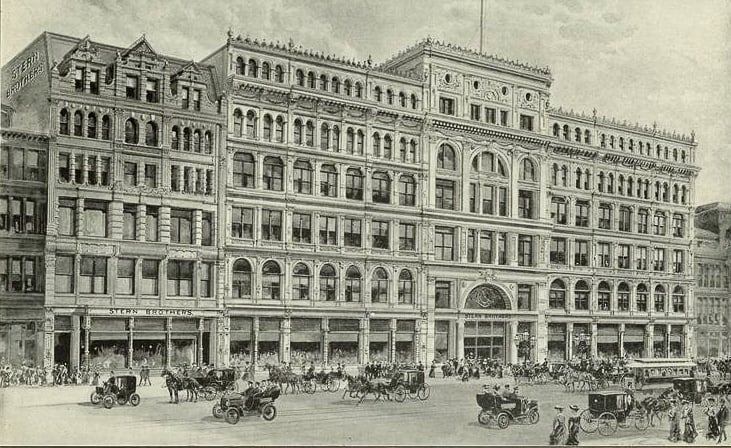Gimbels Department Store: Retail Royalty’s Rise and Fall
Delve into the fascinating history of Gimbels Department Store, a retail giant that once ruled American shopping streets. From its innovative strategies to its iconic presence in popular culture, Gimbels was more than just a store – it was an integral part of the American lifestyle.
Here is a brief overview of key milestones in the journey of Gimbels Department Store.
- The Founding: The humble beginnings of Gimbels Department Store that played a crucial role in shaping modern retail.
- Driving Success: Discover the factors behind Gimbels’ impressive growth and popularity among consumers.
- Innovation at Gimbels: Get an insight into how Gimbels used innovation to stand out from competitors.
- Cinematic Culture: Understand the impact of Gimbels’ portrayal in popular culture, specifically in movies like Elf.
- Gimbels vs Macy’s: Dive into the heated rivalry between two retail giants, Gimbels and Macy’s.
- The Downfall: Uncover the reasons that led to the closure of Gimbels Department Store.
- Gimbels’ Legacy: Find out how Gimbels’ influence has evolved and maintained relevance today.
The story of Gimbels Department Store continues to captivate, offering valuable insights into retail history, strategy, and culture.
A Closer Look at Gimbels Department Store
Gimbels was not just a business, but a cultural phenomenon that influenced the shape of retail in America.
The department store’s rivalry with Macy’s is still remembered as one of the most intense corporate face-offs in history.
Even after its closure, the legacy of Gimbels endures, a testament to its iconic status in American consumer culture.
From its beginnings to its end, the story of Gimbels is a gripping narrative that offers various lessons on successes and pitfalls in retail.
Contents
- The Founding of Gimbels Department Store
- Driving Forces Behind Gimbels’ Success
- Gimbels and Innovation: Product Features
- Gimbels in Cinematic Culture: The Elf Connection
- Competitive Landscape: Gimbels Versus Macy’s
- The Downfall: Causes for Gimbels’ Closure
- From Physical to Digital: Gimbels’ Legacy Today
- Lessons from Gimbels’ Rise and Fall
- Retail Royalty’s Journey
The Founding of Gimbels Department Store

Gimbels Department Store is a testament to the remarkable business acumen of Adam Gimbel and his sons. Originally starting as a humble dry goods store in Milwaukee, they successfully expanded it into an iconic department store chain.
Its rich history, from 1887 to 1987, can be observed in over 280 boxes of records at The New York Public Library. These archives not only provide a fascinating look at the evolution of this groundbreaking retail enterprise but also serve as an educational resource for many.
- Adam Gimbel’s notebooks: Containing meticulous details of his early business strategies.
- Architectural drawings: These include plans for the impressive flagship store at 33rd Street and Herald Square.
- Correspondence: Insightful letters exchanged between Adam and his sons about strategic ventures for business growth.
These valuable documents add depth to our understanding of the store’s path to success. From small beginnings to becoming one of America’s most recognized chains, Gimbels is a testament to progressive entrepreneurship.
They were pioneers in their field, setting new retail standards with their inventive advertising campaigns. Numerous newspaper clippings and print advertisements can be found that indeed prove their innovative techniques in attracting customers.
Photographs of elaborate window displays, stylish interiors, and events portray the unique shopping experience that was synonymous with Gimbels. It wasn’t just about selling products; it was about providing memorable shopping experience for all.
The archives also provide an authentic glimpse into the employee culture through handbooks, financial reports, meeting minutes, and more. It all contributes to a comprehensive understanding of not just their retail operation, but also their commitment to employee welfare.
It is undeniable that Gimbels Department Store was a cornerstone in shaping America’s retail industry. Its story remains an inspiring journey of consistent growth and innovative breakthroughs.
Driving Forces Behind Gimbels’ Success

What contributed to Gimbels’ triumph?
The first factor was their understanding of customer needs.
They realized people wanted affordable, yet quality goods.
Gimbels Innovations
The store introduced pioneering retail concepts.
It was the first to offer a money-back guarantee.
This showed confidence in their products and service.
Unforgettable Shopping Experience
Gimbels focused on enhancing the shopping experience.
Their elaborate holiday window displays were mesmerizing.
This enticed customers and boosted their sales annually.
Employee Satisfaction
A happy team translates to happy customers.
Gimbels understood this principle perfectly.
They prioritized employee welfare, which boosted overall productivity.
Clever Marketing Strategies
Gimbels had exceptional marketing strategies.
The Thanksgiving Day parade is one classic example.
The parade stirred excitement and attracted masses to their store.
Remember, Gimbels’ success didn’t occur in isolation. It was a combination of thoughtful strategies, relentless innovation, superior customer service, powerful marketing, and a dedicated workforce.
Gimbels and Innovation: Product Features

Product development is the lifeblood of any thriving business. It commences with a powerful idea.
This idea is then transformed into a tangible product, ensuring it aligns with the company’s strategic plan and has potential for scalability.
Key steps in this process include market research, design development, product testing, and the ultimate launch.
“A clear understanding of customer needs and continuous feedback are essential to creating products that truly resonate with the target market.”
An effective development strategy adopts a market-oriented approach, focusing on fulfilling customer needs.
Planning is crucial as well. A product roadmap charts the evolution of a specific product, easing its development process.
The pressure to swiftly deliver quality products often poses challenges. Balancing speed with excellence requires strategic management.
Simultaneously, managing stakeholder expectations is vital to ensure alignment with the product development process.
An agile process helps tremendously: iterative development segments the procedure into manageable parts.
The involvement of cross-functional teams cultivates collaboration between different departments, promoting productive communication and comprehensive solutions.
Gimbels in Cinematic Culture: The Elf Connection

Recognized for its roles in classics like “Miracle on 34th Street”, Gimbels was also spotlighted in “Elf”.
This famed department store stood in as Santa’s workshop, adding a sparkle of nostalgia.
By blending the movie’s setting with childhood Christmas specials, Gimbels became an endearing symbol of holiday cheer.
The transformation of the script into a more innocent, PG film allowed this iconic store to thrive in the new context.
Interestingly, much of the final singalong scene was filmed within the confines of Gimbels.
| Scene | Role | Impact |
|---|---|---|
| Santa’s Workshop | Primary filming location | Inspired nostalgic emotions |
| Buddy Changing people | Central plot device | Brought warmth and cheer |
| Miles Finch Fight | Critical comedy scene | Demonstrated commitment to physical comedy |
| Singing Scene with Jovie | Pivotal romantic moment | Showcased unexpected talents, added magic to the film |
| Singalong Finale | Climactic resolution | Encapsulated Christmas spirit |
| Gimbels in “Elf” | ||
The rich cinematic culture of Gimbels shines through, capturing the essence of holiday magic for all to cherish.
Competitive Landscape: Gimbels Versus Macy’s

Gimbel Brothers Department Stores, founded in 1842, were known for retail dominance in cities like New York, Philadelphia, and Milwaukee. You might even recall their famous Thanksgiving Parade which predated Macy’s own show-stopping event.
Their peak glory days were in the 1940s, with over half a million spectators attending their parade in Philadelphia. Gimbel’s even had a starring role in the popular 1947 movie Miracle on 34th Street.
Gimbels’ Diverse Divisions
The New York division of Gimbel’s generated impressive revenues but eventually found itself deeply in the red. Competitors perceived as superior and the rise of discounters like Korvette’s posed formidable challenges.
Struggles and Successes
Philadelphia followed New York into the red ink, with rivals like Wanamaker taking the lead. However, Gimbels fared better in Pittsburgh against upscale competitors like Kaufmann’s.
Milwaukee was a bright spot among Gimbel-branded stores. An acquisition of Schuster’s in 1962 positioned Gimbels as the biggest department store retailer in the city.
A Monumental Legacy
In its 145-year lifespan, Gimbels sold merchandise worth over twenty billion dollars to millions of Americans. Towards the late 1980s however, this retail giant came to an end.
Learn more here about this fascinating part of American retail history.
The Downfall: Causes for Gimbels’ Closure

Gimbels Department Store had its a fair share of challenges leading to its closure. In this post, we’ll delve into these issues.
- Competition: Gimbels faced tough rivalry from other retail giants such as Macy’s and JCPenney.
- Economic Shifts: The store couldn’t keep up with shifting economic conditions and changing consumer demands.
- Management Problems: Internal discord in management played a significant role in the store’s decline.
- Lack of Innovation: Gimbels failed to reinvent itself and keep pace with trends in retailing.
Let’s explore each cause in more depth.
The retail industry is notoriously competitive, and Gimbels was not immune to this pressure. With rivals such as Macy’s and JCPenney commanding large market shares, Gimbels found it hard to compete effectively.
Economic shifts also impacted Gimbel’s business. Changes in consumer tastes and the advent of online shopping posed a challenge to traditional retail formats like Gimbels.
Gimbels’ management problems also contributed to its downfall. Poor leadership decisions, lack of strategic direction, and internal discord placed the store in an increasingly vulnerable position.
Last but not least, Gimbel’s failure to innovate was a significant factor in its closure. The company did not successfully update its operations or product offerings to keep up with the changes in the retail landscape. This rendered it unable to meet the expectations and needs of modern consumers.
From Physical to Digital: Gimbels’ Legacy Today

As you navigate through the digital landscape, you quite likely encounter vestiges of Gimbels. Its impact is far-reaching.
The iconic department store has indeed left a lasting legacy that continues to influence many sectors.
You might wonder how Gimbels shaped the retail industry. Let’s take a look at some facts that shed light on this matter.
| Gimbels’ Era | Legacy |
|---|---|
| 1887 – 1930 | Pioneering customer-centric practices in retail. |
| 1931 – 1960 | Influencing architecture with its distinctive flagship stores. |
| 1961 – 1986 | Parallel growth with online shopping trends. |
| 1987 – Present | Inspiring modern retail strategies and digital platforms. |
| Table 1: Gimbels’ Legacy Over The Years. | |
This table paints a picture of the deep impact of Gimbels on modern retail practices, visible even in our time.
Gimbels was a trendsetter; its customer-focused approach sparked revolutionary changes in retail methodology.
Their infrastructure became an architectural icon, influencing design approaches of numerous establishments around the globe.
The simultaneous rise of Gimbels and e-commerce isn’t a mere coincidence. Their growth trajectories are intricately linked.
The principles embedded by Gimbels continue to inform modern retail strategies and shape thriving digital platforms.
Lessons from Gimbels’ Rise and Fall

Gimbels’ fascinating history offers valuable insights.
Critical analysis of their trajectory is educational for current businesses.
Their story is a testament to the evolving landscape of the retail industry.
Gimbels embraced change, a lesson for businesses in any industry.
They evolved with consumer tastes and preferences, but it wasn’t enough.
Beyond adaptation, their downfall highlights the importance of innovation.
Today’s companies must not only adapt but also foresee industry trends.
Gimbels: A Case Study in Market Adaptation
Their attempt to change with the market was commendable.
Nevertheless, failure to forecast future trends led to their downfall.
Adeptness at anticipating market shifts is crucial for longevity.
Innovation: The Lifeline of Successful Businesses
Innovation was the missing ingredient in Gimbels’ strategy.
Without it, they were unable to rise above market challenges.
Innovation keeps a business competitive and relevant amidst changes.
Embracing Change, Anticipating Trends
Adapting to change isn’t enough. Predicting it is essential.
This foresight enables a business to plan and innovate effectively.
Lessons in Resilience and Persistence
Gimbels’ tale underscores resilience in an unpredictable market.
Their persistence, even in failure, offers lessons on tenacity and endurance.
Retail Royalty’s Journey
Gimbels Department Store, once a retail titan, experienced both phenomenal growth and heartbreaking decline. This powerhouse of American retail thrived due to its innovative sales tactics and customer service. However, unable to adapt to market changes and consumer demands, Gimbels sadly closed its doors forever. Its rise and fall serves as a case study in the challenging dynamics of the retail industry.









